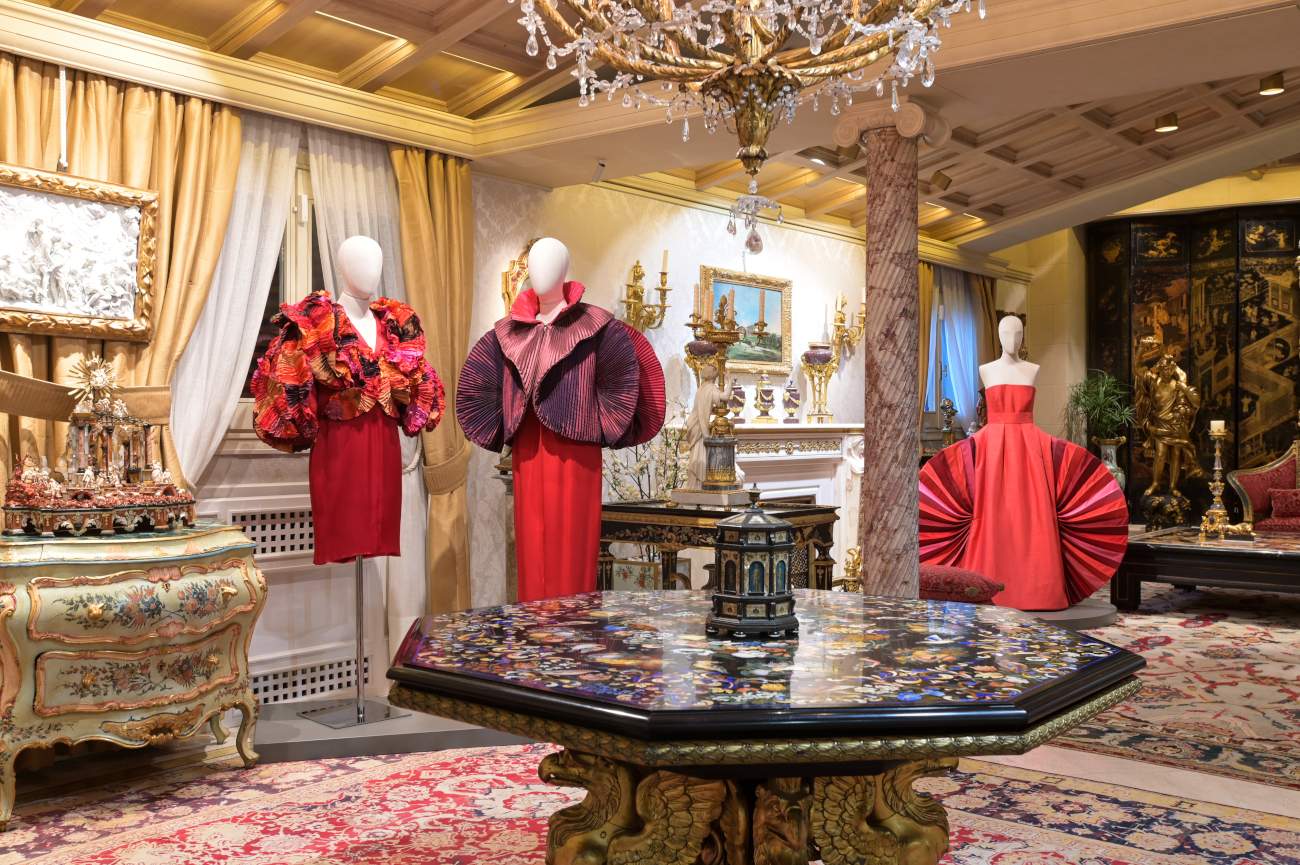Through May 5, 2024, the Casa Museo Fondazione Paolo e Carolina Zani in Cellatica (Brescia) presents the exhibition RED FASHION Roberto Capucci between fire and cinnabar, curated by Massimiliano Capella. The exhibition places sculptures and objects of applied art in Egyptian red porphyry in dialogue with a selection of nine dress-sculptures made from the 1950s to the present by Roberto Capucci, from the Foundation of the same name. Whether iridescent in hue or transformed by light and pleating, the red of Capucci’s sculpture-dresses, thanks in part to the designer’s predilection for fabrics such as silk taffeta or textural fabrics such as Mikado, creates a confrontation with shapes and volumes in red porphyry mottled with white.
In the room named after Canaletto, the path kicks off with Nine Skirts (1956), one of the most iconic dresses of the 20th century and emblematic of the first phase of Capucci’s career. A taffeta sculpture characterized by nine overlapping elements on the skirt, it links Roberto Capucci to two Hollywood movie divas: Marilyn Monroe and Esther Williams. Worn by a comic-book version of Marilyn, the dress appeared in a strip in The Dallas Morning News. Next to Nine Skirts stands out Cinnabar (1995), one of twelve Fabric Architectures made for the Venice Biennale, at the request of the then director of the event’s Visual Arts section. The series, which also includes Sagenite, Fluorite, Lapis Lazuli, Violan, Emanite, Obsidian, Jasper, Antimonite, Pyrite, Allanite and Siderite, testifies to a reflection on natural, mineral and chromatic elements. The two outfits are placed in close connection with the red porphyry Bruciaprofumi, of French production from the early 19th century, part of the Zani Collection.
In the Maggiolini Room, next to tripod tables of Roman production, from the oval top in Egyptian red porphyry from the Zani Collection, appears Fuoco, presented by Capucci in 1985 at the Army National Guard in New York. The taffeta sauvage dress-sculpture, composed of a bodice and pleated flame-like fans in fourteen shades of red, is part of a series inspired by natural elements. In the Salone dell’Ottagono, on the other hand, there is a dialogue between the red of five Capucci creations and that of the porphyry sculptures placed in the hall and beyond the windows overlooking the House Museum’s Impluvium. The latter houses, among others, a series of vases in Egyptian porphyry and gilded bronze of 18th- and 19th-century French manufacture also belonging to the Zani Collection. The orange and red pleated ermesine taffeta Marsina, a tribute to Mozart, was presented by Capucci in 1992 at the Schauspielhaus Theater in Berlin. As in a room of mirrors, the placement is intended to enhance the close correlation between the late 18th-century cut of Capucci’s creation and those painted by Francesco Guardi in the pictorial masterpiece Villa Loredan a Paese (1780) hanging behind the Garniture de cheminée of the House Museum.
The exhibition tour continues with Ventagli, a sculptural dress in taffeta sauvage adorned with fan-like elements in the skirt that, opening as they close, show multiple declinations of red and how the choice of fabrics and workmanship allows for effects comparable to the pictorial use of color. Also in the salon, the crossover between arts and eras continues with two fabric sculptures featuring the iconic pleating of the bodice-bolero, and an invention from the prêt-à-couture collection.
Finally, it speaks of the Orient the Sculpture Dress in dark red velvet with a fan bolero in iridescent red, light blue and purple pleated taffeta, presented in 1987 at the Palazzo Venezia Museum in Rome. Capucci’s work finds its ideal location next to the Chinese lacquers of a Coromandel screen (second half of the 17th century) that is part of the House Museum’s permanent collection.
For info: www.fondazionezani.com
Hours: Tuesday through Friday from 9 a.m. to 1 p.m.; Saturday and Sunday from 10 a.m. to 5 p.m.
Access to the House Museum is allowed only by guided tour by reservation at www.fondazionezani.com
Pictured is the display of sculpture-dresses in the Octagon Hall.
 |
| At the Zani Foundation, Capucci's sculpture-dresses dialogue with art objects made of Egyptian red porphyry |
Warning: the translation into English of the original Italian article was created using automatic tools. We undertake to review all articles, but we do not guarantee the total absence of inaccuracies in the translation due to the program. You can find the original by clicking on the ITA button. If you find any mistake,please contact us.